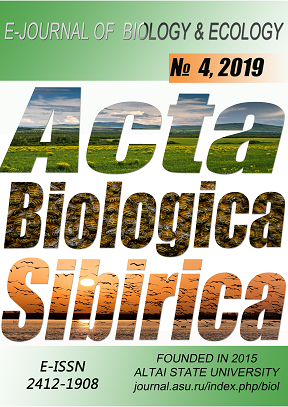Аннотация
В статье представлены результаты многолетнего комплексного исследования эколого-биологических особенностей урбанофлоры различных биотопов городов Орловской области: Орла, Мценска, Ливен, Болхова, Малоархангельска, Новосиля и Дмитровска. Флора города Орла насчитывает 913 видов, Ливен – 786, Мценска – 777, Болхова – 780, Новосиля – 775, Малоархангельска – 776, Дмитровска – 777. В ходе исследований охарактеризована таксономическая структура урбанофлор как один из показателей зональной и эколого-топологической приуроченности флоры. Сопоставление полных флористических списков городов Орловской области показало высокую степень флористического сходства, что свидетельствует о высокой степени единства урбанофлор и сглаживании зональных черт. Отмечается высокая степень сходства аборигенной и адвентивной фракции флор различных городов. Высокая корреляция между систематической структурой ведущих семейств различных типов биотопов связана с единством состава флоры региона и свидетельствует о тесном взаимодействии естественной и урбанизированной флор.
Литература
Agafonova LA. 2010. Flora of the Belgorod city [dissertation]. Moscow.
Arep’eva LA. 2011. Features of ruderal urban ecotopes flora of Kursk region. Uchenye zapiski. Elektronnyi nauchnyi zhurnal Kurskogo gosudarstvennogo universiteta 1(17): 48-53.
Arep’eva LA. 2016. Zonal regularities of formation of the Kursk city synanthropic vegetation. Ekologiya 4: 259-263.
Burda RI, Protopopova VV, Fedoronchuk MM, Shevera MV. 2013. Synanthropization of flora and vegetation – a threat to biodiversity (II All-Ukrainian Sci. Conf. “Synanthropization of vegetation cover of Ukraine”). Bulletin of Ukrainian National Academy of Science 2: 77–80.
Emelyanova OYu, Khromova TM. 2015. The natural habitats of the cities of Orel region. Sovremennoe sadovodstvo – Contemporary horticulture 4: 97–104.
Fomina OV, Tokhtar’ VK. 2010. The structure of flora of urban aglomeration of Belgorod: Nauchnye vedomosti. Seriya Estestvennye nauki 21(13): 28–32.
Grigorevskaya AYa, Lepeshkina LA, Zelepukin DS. 2012. Flora of the Voronezh urban district of Voronezh city: biogeographical, landshaftno-ecological, historical aspects: Samarskaya Luka: problemy regional’noi i global’noi ekologii 21(1): 5–158.
Il’minskih NG. 1994. Ecotopological structure of the urban flora. In: Aktual'nye problemy sravnitel'nogo izucheniya flor: Proceed. III Conf on Comparative Floristics. Kungur. St.-Peterburg.
Il’minskikh NG, Tarasova ЕМ. 1992. For the protection of phytogenetic fund of the urban flora. Vestnik Udmurtskogo universiteta 3: 90–93.
Ishbirdina ML, Ishbirdin AR. 1992. Urbanization as a factor of anthropogenic evolution of flora and vegetation. Zhurnal obshchei biologii 53(2): 211–224.
Khromova TM, Emelyanova OYu, Kondrashkin AYu. 2017. Partial flora of ruderal biotopes in towns of Orel region. Sovremennoe sadovodstvo (Contemporary horticulture) 4: 121-130.
Khromova TM, Emelyanova OYu, Tsoi MF. 2016. Ecological assessment of the state of woody plants of the decorative group of cultivated biotopes of the Orel region. Plodovodstvo i yagodovodstvo Rossii XXXXVI: 409-412.
Kostin AE, Avdeev YuM. 2015. Geobotanical research of the biodiversity in the urban environment. Vestnik Krasnoyarskogo gosudarstvennogo agrarnogo universiteta 3: 19–23.
Kuleshova YuV. 2018. About features of biomorphological structure of urbanized territories flora (on the example of Sosnovoborsk, Krasnoyarsk region). Vestnik KrasGAU 2(137): 253–259.
Panasenko NN. 2002. Urban flora of the South-Western non-Chernozem region of Russia (on the example of the Bryansk region’s cities) [dissertation]. Bryansk.
Poluyanov AV. 2001. Flora of Kursk and its environs: some changes in 100 years. In: Materialy nauchogo soveshchaniya “Floristicheskie issledovaniya v Central'noj Rossii na rubezhe vekov”, Ryazan'.
Problemy izucheniya adventivnoi i sinantropnoi flory v regionah SNG. 2003. Proceed. Sc. Conf. Moscow: Tula.
Prokopev EP, Rybina TA. 2010. Experience of monitoring synanthropization and anthropogenic transformation of vegetation of specially protected areas in Tomsk. Vestnik Tomskogo gosudarstvennogo universiteta. Biologiya 3(11): 109–118.
Senator SA, Kostina NV, Saksonov SV. 2013. Diversity dependence of species of urban floras on a number of factors. Vestnik Udmurtskogo universiteta. Seriya Biologiya. Nauki o Zemle 2: 23–29.
Shadrin VA. 2000. Floristic parameters in the estimation of synanthropization of the flora. Sravnitel'naya floristika na rubezhe III tysyacheletiya. St.-Peterburg.
Sklyar EA. 2015. Modern formation trends of adventitious flora fraction in Kursk. Nauchnye vedomosti Belgorodskogo gosudarstvennogo universiteta. Seriya: Estestvennye nauki 21(218): 31-37.
Tokhtar’ VK, Fomina OV. 2013. Peculiarities of formation of floras in an urban environment in the South-West of the Central Russian upland. Belgorod.
Tretyakova AS. 2016. Characteristics of taxonomic structure of flora in the Middle Urals urban areas (Sverdlovsk Region). Samarskij nauchnyj vestnik 1(14): 66-71.
Vinogradova YuK, Maiorov SR, Khorun LV. 2009. Black book of flora of Central Russia. Alien plant species in the ecosystems of Middle Russia. Moscow: GEOS.
Yurtsev BA, Semkin BI. 1980. Studies of concrete and partial floras with the aid of mathematical methods. Botanicheskii zhurnal 65(12): 1706–1718.
Zavidovskaya TS. 2010. Flora of Borisoglebsk. Vestnik Moskovskogo gosudarstvennogo universiteta lesa – Lesnoj vestnik 3: 192-198.
Авторы, публикующиеся в данном журнале, соглашаются со следующими условиями:
a. Авторы сохраняют за собой права на авторство своей работы и предоставляют журналу право первой публикации этой работы с правом после публикации распространять работу на условиях лицензии Creative Commons Attribution License, которая позволяет другим лицам свободно распространять опубликованную работу с обязательной ссылокой на авторов оригинальной работы и оригинальную публикацию в этом журнале.
b. Авторы сохраняют право заключать отдельные договора на неэксклюзивное распространение работы в том виде, в котором она была опубликована этим журналом (например, размещать работу в электронном архиве учреждения или публиковать в составе монографии), с условием сохраниения ссылки на оригинальную публикацию в этом журнале. с. Политика журнала разрешает и поощряет размещение авторами в сети Интернет (например в институтском хранилище или на персональном сайте) рукописи работы как до ее подачи в редакцию, так и во время ее редакционной обработки, так как это способствует продуктивной научной дискуссии и положительно сказывается на оперативности и динамике цитирования статьи

